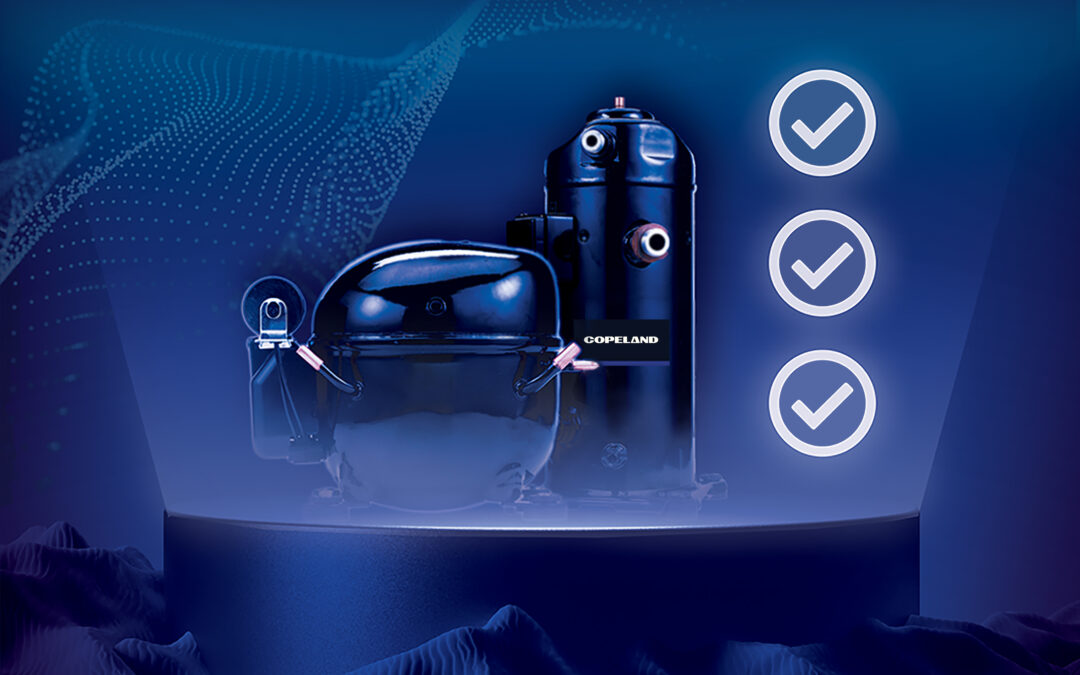*On June 1, 2023 Emerson’s Climate Technologies business became a new standalone company – Copeland. Though our name has changed, we are building on more than a century of HVACR innovation and industry leadership, and Copeland continues to offer the same products, industry stewardship, and learning opportunities you’ve grown to trust. Information found on this webpage posted before June 1, 2023 may contain our old name or branding, but you can be at ease knowing it was created with the knowledge and expertise of Copeland.
The commercial refrigeration and air conditioning sectors are currently experiencing an active period of refrigerant rulemaking. As we move through the first quarter of 2021, our industry is evaluating a variety of regulatory activities and climate initiatives — at both the state and federal levels — that govern the transition to lower global warming potential (GWP) refrigerants and the safe use of flammable alternatives. I recently co-hosted an E360 webinar with Jennifer Butsch, Emerson’s regulatory affairs director, to discuss current developments and explore their potential impacts on our industry. We were joined by Helen Walter-Terrinoni, vice president of regulatory affairs for the Air-Conditioning, Heating, and Refrigeration Institute (AHRI).

As global regulatory efforts to phase down the use of HFC refrigerants continue in earnest, the transition to alternatives with lower GWP is gaining momentum in the U.S. At the state level, California is preparing for its next phase of rulemaking, while more U.S. Climate Alliance states leverage the Environmental Protection Agency’s (EPA) Significant New Alternatives Policy (SNAP) Rules 20 and 21 as the bases for their own environmental initiatives. In addition, a new presidential administration and the passing of new federal legislation represent significant shifts in U.S. regulatory dynamics — resuming our global participation in combating climate change and giving the EPA authority to govern HFCs.
But the progression of refrigerant rulemaking along both state and federal lines continues to create complexity for an industry that seeks guidance in understanding and applying an ever-evolving, complex mix of regulations.
California Air Resources Board (CARB) Seeks to Finalize Proposals
In 2019, California was the first state to adopt EPA SNAP Rules 20 and 21 in their entirety. Since then, CARB has developed additional proposals to meet its stated 2030 emissions-reduction targets. For commercial refrigeration, these proposed refrigerant regulations target the installation of new refrigeration systems greater than 50lbs:
-
- 150 GWP limit for systems installed in new facilities
- In existing facilities, food retailers must choose from one of the following company-wide reduction targets:
- Reduce their weighted average GWP below 1,400
- Achieve a 55% or greater reduction in their greenhouse gas potential (GHGp) below 2019 baseline levels by 2030
- Other GWP limits for systems in existing facilities include a 750 limit for ice rinks and a 1500 – 2000 limit for industrial refrigeration
In air conditioning applications, the CARB proposal targets a 750 GWP limit across multiple end uses in the coming years:
-
- 2023: room AC and dehumidifiers
- 2024: AC chillers (consistent with SNAP Rule 21)
- 2025: residential and commercial AC
- 2026: variable refrigerant flow (VRF) systems
CARB has also introduced its Refrigerant Recycle, Recovery and Reuse (R4) program, which proposes new air conditioning equipment in 2023 and 2024 to use reclaimed R-410A refrigerant in an amount equal to 10% of equipment operating charge in California. In addition, CARB has stated that it will expand its R4 program by introducing new rulemaking this year.
U.S. Climate Alliance States Adopt Legislation
Among the 25 member states that have joined the U.S. Climate Alliance, nine have finalized legislation for adopting SNAP Rules 20 and 21 into law. Like the original EPA rules, the timings of enforcement dates are end-use specific and designed to be phased in over several years. But because the start dates of these rules differ among the nine member states, our industry faces an increasingly complex patchwork of compliance schedules.
As Walter-Terrinoni pointed out in the webinar, the prospect of new federal legislation may give these and other states the option to pursue a consistent, nationwide approach to the refrigeration phase-down. States could place their focus on the local level, where they can further the advancement of building codes and safety standards.
Federal HFC Phase-down Takes AIM
Regulatory activity is also picking up at the federal level, starting with the EPA’s proposed SNAP Rule 23, which reaffirms its commitment to approve low-GWP refrigerants. The proposal lists several mildly flammable (A2L) refrigerants, including R-452B, R-454A, R-454B, R-454C, R-457 and R-32 as acceptable, subject to use conditions in new residential and light commercial air conditioners and heat pumps. For retail food refrigeration — medium-temperature, stand-alone units — SNAP Rule 23 lists A1 refrigerants R-448A, R-449A and R-449B as acceptable, subject to narrowed use limits. Emerson and other industry stakeholders have asked for further clarification on these restrictions, as these A1s have already been listed as acceptable without limitations in many other commercial refrigeration applications.
As part of major pandemic relief legislation, the American Innovation and Manufacturing (AIM) Act was passed and signed into law in late 2020. This legislation gives the EPA the authority to phase down HFC production and consumption limits in a manner consistent with the Kigali Amendment to the Montreal Protocol within nine months. It also authorizes the EPA to regulate HFCs through sector based rulemaking and establish standards for HFC management — servicing, repair, recover, recycle and reclaim — similar to CARB’s R4 program. This is welcome news for our industry, as it paves the way for a federally guided, low-GWP refrigerant transition, which would minimize the complexities of differing state-led regulations.
Under the new Biden administration, the U.S. has rejoined the Paris Agreement and is taking steps to ratify the Kigali Amendment. These are among many early indications of this administration’s commitment to combat climate change at home and abroad.
A2L, A3 Standards and Codes Progress
With the industry moving toward the use of flammable A2L and A3 refrigerants to achieve lower-GWP goals, the technical committees and governing bodies who provide guidelines on how to safely use these refrigerants and related equipment are currently updating their safety standards. Among the updates that many are closely watching are the proposed changes to the Underwriter’s Laboratory (UL) 60335-2-89 standard, which would increase the charge limits in self-contained and remote refrigeration applications. While the industry expects this proposal potentially to be finalized by the end of the year, it’s important to remember that once established, these standards will take several years to make their way into the building codes and local standards needed to permit the widespread use of flammable refrigerants.
To learn more details about each of these important regulatory developments, please view our on-demand webinar.

Electrical component considerations for A2L system safety
Electrical component considerations for A2L system safety As a new refrigerant category in the...

A2L refrigerant regulation updates: what you need to know today
Preparing for the approval and safe use of A2Ls in commercial refrigeration applications The move...

Address Efficiency Mandates with Compression Technologies
Strategies for complying with DOE and ENERGY STAR® in self-contained and remote condensing units...
